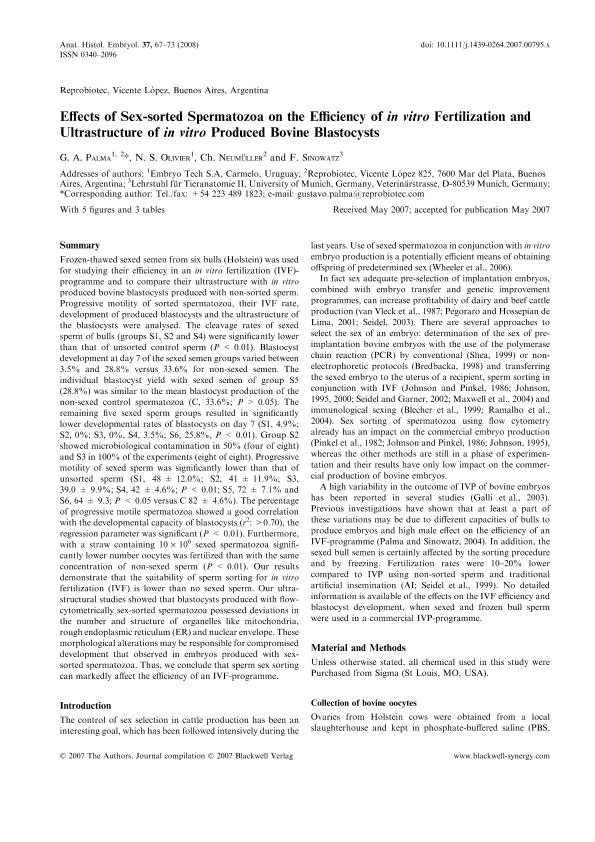Artículo
Effects of sex-sorted spermatozoa on the efficiency of in vitro fertilization and ultrastructure of in vitro produced bovine blastocysts
Fecha de publicación:
02/2008
Editorial:
Blackwell Publishing
Revista:
Anatomia Histologia Embryologia-Journal Of Veterinary Medicine Series C
ISSN:
0340-2096
Idioma:
Inglés
Tipo de recurso:
Artículo publicado
Clasificación temática:
Resumen
Frozen-thawed sexed semen from six bulls (Holstein) was used for studying their efficiency in an in vitro fertilization (IVF)-programme and to compare their ultrastructure with in vitro produced bovine blastocysts produced with non-sorted sperm. Progressive motility of sorted spermatozoa, their IVF rate, development of produced blastocysts and the ultrastructure of the blastocysts were analysed. The cleavage rates of sexed sperm of bulls (groups S1, S2 and S4) were significantly lower than that of unsorted control sperm (P < 0.01). Blastocyst development at day 7 of the sexed semen groups varied between 3.5% and 28.8% versus 33.6% for non-sexed semen. The individual blastocyst yield with sexed semen of group S5 (28.8%) was similar to the mean blastocyst production of the non-sexed control spermatozoa (C, 33.6%; P > 0.05). The remaining five sexed sperm groups resulted in significantly lower developmental rates of blastocysts on day 7 (S1, 4.9%; S2, 0%; S3, 0%, S4, 3.5%; S6, 25.8%, P < 0.01). Group S2 showed microbiological contamination in 50% (four of eight) and S3 in 100% of the experiments (eight of eight). Progressive motility of sexed sperm was significantly lower than that of unsorted sperm (S1, 48 ± 12.0%; S2, 41 ± 11.9%; S3, 39.0 ± 9.9%; S4, 42 ± 4.6%; P < 0.01; S5, 72 ± 7.1% and S6, 64 ± 9.3; P < 0.05 versus C 82 ± 4.6%). The percentage of progressive motile spermatozoa showed a good correlation with the developmental capacity of blastocysts (r2: >0.70), the regression parameter was significant (P < 0.01). Furthermore, with a straw containing 10 × 106 sexed spermatozoa significantly lower number oocytes was fertilized than with the same concentration of non-sexed sperm (P < 0.01). Our results demonstrate that the suitability of sperm sorting for in vitro fertilization (IVF) is lower than no sexed sperm. Our ultrastructural studies showed that blastocysts produced with flow-cytometrically sex-sorted spermatozoa possessed deviations in the number and structure of organelles like mitochondria, rough endoplasmic reticulum (ER) and nuclear envelope. These morphological alterations may be responsible for compromised development that observed in embryos produced with sex-sorted spermatozoa. Thus, we conclude that sperm sex sorting can markedly affect the efficiency of an IVF-programme.
Archivos asociados
Licencia
Identificadores
Colecciones
Articulos(CICYTTP)
Articulos de CENTRO DE INV.CIENT.Y TRANSFERENCIA TEC A LA PROD
Articulos de CENTRO DE INV.CIENT.Y TRANSFERENCIA TEC A LA PROD
Citación
Palma, Gustavo Adolfo; Olivier, N. S.; Neumüller, Ch.; Sinowatz, F.; Effects of sex-sorted spermatozoa on the efficiency of in vitro fertilization and ultrastructure of in vitro produced bovine blastocysts; Blackwell Publishing; Anatomia Histologia Embryologia-Journal Of Veterinary Medicine Series C; 37; 1; 2-2008; 67-73
Compartir
Altmétricas




